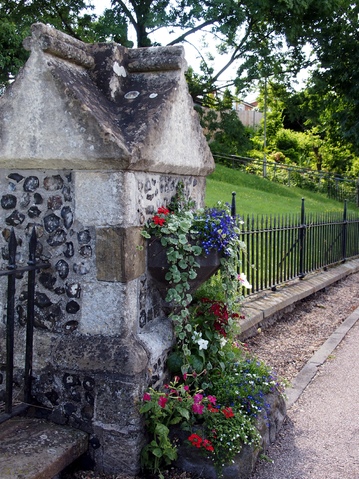
Stanstead Abbotts Local History Society

Drinking fountains in Stanstead Abbotts.
Ron Davies
The study of local history produces a number of interesting features, some of which have great significance, others not so great. The history of Stanstead Abbotts is no exception, as it evident from the SALHS website and the new history of the village written by Ron Dale.
Perhaps one of the features of minor significance is the presence of not one, but two, drinking fountains, one with a dog basin attached and the other originally with a horse or cattle trough, which has now sadly gone. This one does look a little in need of restoration although not the sort which has recently been applied to the drinking fountain in Hertford! This has been painted with magnolia and mustard yellow paint, supposedly to restore it!! Understandably there is a local outcry.
The first is found on one of the pillars supporting the fence outside St Andrews parish church in Cappell Lane, the second outside the parish room and school in Roydon Road. The first dates from 1881, being built at the same time as the church; the second has the date 1884 engraved on it, which was the year after the parish room was opened.. For some reason, while the one outside the church is a Grade II Listed Building, the other is not. Both were paid for by a brewer (!!) the brewer in question being Thomas Fowell Buxton, the first owner of Easneye Mansion. Maybe there is more than meets the eye in all this and we will try to fill in some of the background.

Drinking fountains in the nineteenth century
The first steps to provide safe water for drinking began in the 1850s, in Lancashire
and in northern cities including Hull (which still has at least a score of such fountains).
However, the provision of such fountains (and soon after of horse and cattle troughs,
as we shall see) really took off in 1859 which the formation of the “Metropolitan
Free Drinking Fountain Association” in London in 1859. The moving spirit behind it
was Samuel Gurney, a banker and MP, who soon made it one of his main preoccupations.
It may be significant that he was Thomas Fowell Buxton’s brother-
To quote the official history of the Association:
“The supply of drinking water generally available to the poorer classes in London was in those
days lamentably deficient both in quantity and quality, coming as it did mainly from
pumps and surface wells. A report made in 1866 showed how contaminated this water
was, and not only was the impurity of the water held to be largely responsible for
the outbreaks of cholera in 1848-
Prince Albert, the Archbishop of Canterbury and other public figures supported the work, which,
to cite a Resolution adopted at the inaugural meeting:
“That, where the erection of free drinking fountains, yielding pure cold water, would confer a boon on all classes, and especially the poor, an Association be formed for erecting and
promoting the erection of such fountains in the Metropolis, to be styled “The Metropolitan
Free Drinking Fountain Association”, and that contributions be received for the purposes
of the Association. That no fountain be erected or promoted by the Association which
shall not be so constructed as to ensure by filters, or other suitable means, the
perfect purity and coldness of the water; and that it is desirable the water-
In the first two years 85 drinking fountains had been erected. By 1865 the majority
of those built had dog basins attached. In that year the name of the society was
changed to “The Metropolitan Drinking-
“The intense suffering which is experienced by all kinds of animals from thirst in the streets of London has long been a source of anxiety and grief to all humane and benevolent persons, and the need of public free supplies of water, both for man and beast, has now been greatly increased by the fact of most of the pumps having been closed, either in consequence of the impurity of the
water during the late attack of cholera, or through the drainage of the surface wells by the low level sewers.”
And in 1872:
“The sufferings which were endured by parched and wearied animals in our streets before this Society undertook the erection of cattle troughs in addition to drinking fountains must have been
past all imagination.”
Some inn keepers provided a wooden trough outside their premises for horses, but
the car-
others were expected to patronise the establishment! One such had the sign outside
“All that water their horses here, Must pay a penny or have some beer.”
Saint Andrews Church in
Stanstead Abbotts.
Now a plant container.
The fountain and the railings
are listed and protected.